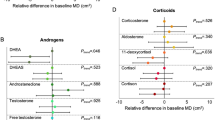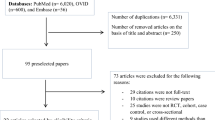Abstract
Differences in the parenchymal pattern of the breast on mammography reflect differences in the amounts of stromal, epithelial, and fat tissue present in the breast. Stroma and epithelium are radiologically dense, whereas fat is lucent. Extensive areas of mammographically dense breast tissue are strongly associated with an increased risk of breast cancer. A variety of interventions, including gonadotropin-releasing hormone inhibitor, tamoxifen, stopping hormone replacement therapy (HRT), and adopting a low-fat, high-carbohydrate diet, all influence the tissue composition of the breast and reduce mammographic densities. Of the interventions examined to date, only tamoxifen has been shown to reduce the incidence of breast cancer, at least in the short term. Conversely, HRT, which increases density, also increases risk of breast cancer. These results suggest that mammographic density may be a short-term marker of the effect on the breast of potential preventive interventions for breast cancer.
Similar content being viewed by others
References and Recommended Reading
Ingleby H, Gerson-Cohen J: Comparative Anatomy, Pathology and Roentgenology of the Breast. Philadelphia: University of Philadelphia Press; 1960.
Wolfe JN: Breast patterns as an index of risk for developing breast cancer. Am J Roentgenol 1976, 126:1130–1139.
Wolfe JN: Risk for breast cancer development determined by mammographic parenchymal pattern. Cancer 1976, 37:2486–2492.
Saftlas AF, Szklo M: Mammographic parenchymal patterns and breast cancer risk. Epidemiol Rev 1987, 9:146–174.
Oza AM, Boyd NF. Mammographic parenchymal patterns: a marker of breast cancer risk. Epidemiol Rev 1993, 15:196–208.
Boyd NF, O’Sullivan B, Campbell JE, et al.: Mammographic signs as risk factors for breast cancer. Br J Cancer 1982, 45:185–193.
Brisson J, Merletti F, Sadowsky NL: Mammographic features of the breast and breast cancer risk. Am J Epidemiol 1982, 115:428–437.
Brisson J, Morrison AS, Kopans DB: Height and weight, mammographic features of breast tissue, and breast cancer risk. Am J Epidemiol 1984, 119:371–381.
Brisson J, Verreault R, Morrison A, et al.: Diet, mammographic features of breast tissue, and breast cancer risk. Am J Epidemiol 1989, 130:14–24.
Wolfe JN, Saftlas AF, Salane M: Mammographic parenchymal patterns and quantitative evaluation of mammographic densities: a case-control study. Am J Roentgenol 1987, 148:1087–1092.
Saftlas AF, Hoover RN, Brinton LA, et al.: Mammographic densities and risk of breast cancer. Cancer 1991, 67:2833–2838.
Boyd NF, Byng JW, Jong RA, et al.: Quantitative classification of mammographic densities and breast cancer risk: results from the Canadian National Breast Screening Study. J Natl Cancer Inst 1995, 87:670–675.
Byrne C, Schairer C, Wolfe J, et al.: Mammographic features and breast cancer risk: effects with time, age, and menopause status. J Natl Cancer Inst 1995, 87:1622–1629.
Kato I, Beinart C, Bleich A, et al.: A nested case-control study of mammographic patterns, breast volume, and breast cancer (New York City, NY, United States). Cancer Causes Contol 1995, 6:431–438.
Easton DF, Ford D, Bishop DT: Breast cancer consortium: breast and ovarian cancer incidence in BRCA1-mutation carriers. Am J Hum Genet 1995, 56:265–271.
Struewing JP, Hartge P, Wacholder S, et al.: The risk of cancer associated with specific mutations of BRCA1 and BRCA2 among Ashkenazi Jews. N Engl J Med 1997, 336:1401–1408.
Grove JS, Goodman MJ, Gilbert F: Factors associated with mammographic pattern. Br J Radiol 1985, 58:21–25.
Grove JS, Goodman MJ, Gilbert FI, Clyde D. Factors associated with breast structures in breast cancer patients. Cancer 1979; 43:1895–1899.
Wolfe JN. Breast parenchymal patterns and their changes with age. Radiology 1976, 121:545–552.
Boyd NF, Greenberg C, Lockwood G, et al.: Effects at two years of a low-fat, high-carbohydrate diet on radiologic features of the breast: results from a randomized trial. J Natl Cancer Inst 1997, 89:488–496.
Kaufman Z, Garstin WIH, Hayes R, et al.: The mammographic parenchymal patterns of nulliparous women and women with a family history of breast cancer. Clin Radiol 1991, 43:385–388.
Whitehead J, Carlile T, Kopecky KJ, et al.: The relationship between Wolfe’s classification of mammograms, accepted breast cancer risk factors, and the incidence of breast cancer. Am J Epidemiol 1985, 122:994–1006.
Brisson J, Sadowski NL, Twaddle JA, et al.: The relation of mammographic features of the breast to breast cancer risk factors. Am J Epidemiol 1982, 115:438–443.
Bergkvist L, Tabar L, Bergstrom R, Adami HO: Epidemiologic determinants of the mammographic parenchymal pattern: a population-based study within a mammographic screening program. Am J Epidemiol 1987, 126:1075–1081.
Ernster VL, Sacks ST, Peterson CA: Mammographic parenchymal patterns and risk factors for breast cancer. Radiology 1980, 134:617–620.
de Waard F, Rombach JJ, Collette HJA, Slotboom B: Breast cancer risk associated with reproductive factors and breast parenchymal patterns. J Natl Cancer Inst 1984, 72:1277–1282.
Kelsey JL, Gammon MD, John ES: Reproductive factors and breast cancer. Epidemiol Rev 1993, 15:36–47.
Pike MC, Krailo MD, Henderson BE, et al.: ‘Hormonal’ risk factors, ‘breast tissue age’ and the age-incidence of breast cancer. Nature 1983, 303:767–770.
Rosner B, Colditz G: Nurses’ Health Study: log-incidence mathematical model of breast cancer incidence. J Natl Cancer Inst 1996, 88:359–364.
Spicer D, Pike M, Lobo R, et al.: Gonadotropin hormone releasing hormone agonists <Gnrha> and prevention of familial breast cancer. Adv Cancer Control 1990, 339:193–199.
Ursin G, Astrahan MA, Salane M, et al.: The detection of changes in mammographic densities. Cancer Epidemiol Biomarkers Prev 1998, 7:43–47.
Brisson J, Brisson B, Coté G, et al.: Tamoxifen and mammographic breast densities. Cancer Epidemiol Biomarkers Prev 2000, 9:911–915. Mammograms from subjects in the National Surgical Adjuvant Breast Project Cancer Prevention Trial showed a reduction in the number with high-risk breast patterns after 3 years of tamoxifen.
Chow CK, Venzon D, Jones EC, et al.: Effect of tamoxifen on mammographic density. Cancer Epidemiol Biomarkers Prev 2000, 9:917–921. Mammograms from patients participating in a pilot study of tamoxifen and 4-HPR showed a decrease in high-risk appearance after 2 years of tamoxifen. Quantitative methods of assessing mammograms showed larger effects of tamoxifen than did qualitative approaches.
Atkinson C, Warren R, Bingham SA, Day NE: Mammographic patterns as a predictive biomarker of breast cancer risk: effect of tamoxifen. Cancer Epidemiol Biomarkers Prev 1999, 8:863–866. Mammograms in postmenopausal women with breast cancer show reduction in high-risk appearance after treatment with tamoxifen.
Lundström E, Wilczek B, von Palffy Z, et al.: Mammographic breast density during hormone replacement therapy: differences according to treatment. Am J Obstet Gynecol 1999, 181:348–352. Continuous combination hormone replacement therapy increases breast density more than does estrogen alone, or cyclical combination therapy.
Rutter CM, Mandelson MT, Laya MB, et al.: Changes in breast density associated with initiation, discontinuation, and continuing use of hormone replacement therapy. JAMA 2001, 285:171–176. Compared with non-users, women starting hormone replacement therapy are more likely to show an increase in mammographic density, and those stopping are more likely to show a decrease in density.
Freedman F, San Martin J, O’Gorman J, et al.: Digitized mammography: a clinical trial of postmenopausal women randomly assigned to receive raloxifene, estrogen, or placebo. J Natl Cancer Inst 2001, 93:51–56. In a randomized trial of prevention for osteoporosis, estrogen increased mammographic density, whereas raloxifene did not increase or decrease density.
Byrne C, Colditz GA, Willet WC, et al.: Plasma insulin-like growth factor (IGF) I, IGF-binding protein 3, and mammographic density. Cancer Res 2000, 60:3744–3748. A cross-sectional study in the cohort of the Nurses’ Health Study found higher blood levels of IGF-I to be associated with a greater degree of mammographic density.
Wang DY, De Stavola BL, Bulbrook RD, et al.: The permanent effect of reproductive events on blood prolactin levels and its relation to breast cancer risk: a population study of postmenopausal women. Eur J Cancer Clin Oncol 1988, 24:1225–1231.
Reyes FI, Winter JSD, Faiman C: Pituitary-ovarian relationships preceding the menopause. Am J Obstet Gynecol 1977, 129:557–564.
Andersen JR, Schroeder E, Lebech PE: The effect in postmenopausal women of natural human and artificial oestrogens on the concentration in serum of prolactin. Acta Endocrinol 1980, 95:433–437.
Fisher B, Costantino JP, Wickerham DL, et al.: Tamoxifen for prevention of breast cancer: report of the National Surgical Adjuvant Breast and Bowel Project P-1 Study. J Natl Cancer Inst 1998, 90:1371–1388.
Collaborative Group on Hormonal Factors in Breast Cancer: Breast cancer and hormone replacement therapy: collaborative reanalysis of data from 51 epidemiological studies of 52,705 women with breast cancer and 108,411 women without breast cancer. Lancet 1997, 350:1047–1059.
Author information
Authors and Affiliations
About this article
Cite this article
Boyd, N.F., Martin, L.J., Stone, J. et al. Mammographic densities as a marker of human breast cancer risk and their use in chemoprevention. Curr Oncol Rep 3, 314–321 (2001). https://doi.org/10.1007/s11912-001-0083-7
Issue Date:
DOI: https://doi.org/10.1007/s11912-001-0083-7




